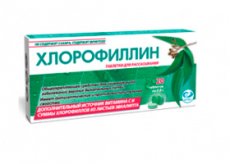Medical expert of the article
New publications
Preparations
Chlorophyllin
Last reviewed: 03.07.2025

All iLive content is medically reviewed or fact checked to ensure as much factual accuracy as possible.
We have strict sourcing guidelines and only link to reputable media sites, academic research institutions and, whenever possible, medically peer reviewed studies. Note that the numbers in parentheses ([1], [2], etc.) are clickable links to these studies.
If you feel that any of our content is inaccurate, out-of-date, or otherwise questionable, please select it and press Ctrl + Enter.

Indications Chlorophyllin
It is used for septic disorders of staphylococcal origin (arising from infections or after childbirth or operations), as well as for complications of staphylococcal origin after surgical procedures (purulent wounds and inflammation):
- burn diseases;
- endocarditis of staphylococcal origin in individuals who have undergone surgery in the heart area;
- pulmonary abscess, pneumonia, and pleurisy;
- inflammation of the peritoneum;
- endometritis;
- osteomyelitis;
- sepsis developing after an abortion, and in addition, subacute or acute inflammation of the internal organs of the genital system that are not related to the abortion or the process of childbirth;
- pyelonephritis or urosepsis of a purulent-destructive nature (combined treatment).
It is also prescribed to eliminate diseases caused by antibiotic-resistant non-staphylococcal pathogens (for example, tuberculosis of any localization, erysipelas, and infections caused by listeria).
Pharmacodynamics
Chlorophyllin is an antiseptic with antibacterial (bacteriostatic and bactericidal) and etiotropic activity against staphylococci that are resistant and dependent on antibiotics.
The drug is capable of eliminating antibiotic resistance plasmids in various pathogenic organisms that provoke the development of bacterial infections. It also increases the oxygen level inside tissues and has a pronounced detoxifying effect. Because of this, it is often used in conditions during which there is a weakening of the immune defense, and in addition to eliminating tissue hypoxia and increasing the effectiveness of the effects of antibacterial drugs.
During experimental tests, the tropism exerted by this drug on lung tissue was revealed, as well as the absence of teratogenic and mutagenic, and at the same time carcinogenic and embryotoxic effects.
Bactericidal values of the drug in the blood develop immediately after intravenous injection of 8 ml of a 0.25% preparation; bacteriostatic indicators are observed when administering 4 ml of the drug. Within the therapeutic limits, the substance is retained for about 6 hours on average, so the most optimal solution is to use the drug four times a day.
Dosing and administration
The drug should be administered slowly by intravenous method. This procedure is used for pneumonia, septic disorders and burn diseases.
It is necessary to dilute a 0.25% solution of the drug (2 ml) with sterile saline (38 ml). The proportions are thus 1:20. The medicine is prepared ex tempore. The finished solution should be completely transparent, without any sediment or flakes.
The substance should be administered daily intravenously in a dosage of 40 ml 4 times a day. This course lasts 4-5 days.
To treat pyothorax or peritonitis, the drug should be used daily for 5-8 days. Chlorophyllin should be administered into the pleural cavity using a drainage tube. Before the procedure, the drug should be diluted in a novocaine solution (0.25%) in a ratio of 1:20. The substance is prepared ex tempore.
Use Chlorophyllin during pregnancy
It is prohibited to prescribe Chlorophyllin to pregnant women.
Storage conditions
Chlorophyllin should be kept in a dark place, out of reach of small children. Temperature values are within the range of 15-25°C.
 [ 22 ]
[ 22 ]
Attention!
To simplify the perception of information, this instruction for use of the drug "Chlorophyllin" translated and presented in a special form on the basis of the official instructions for medical use of the drug. Before use read the annotation that came directly to medicines.
Description provided for informational purposes and is not a guide to self-healing. The need for this drug, the purpose of the treatment regimen, methods and dose of the drug is determined solely by the attending physician. Self-medication is dangerous for your health.

